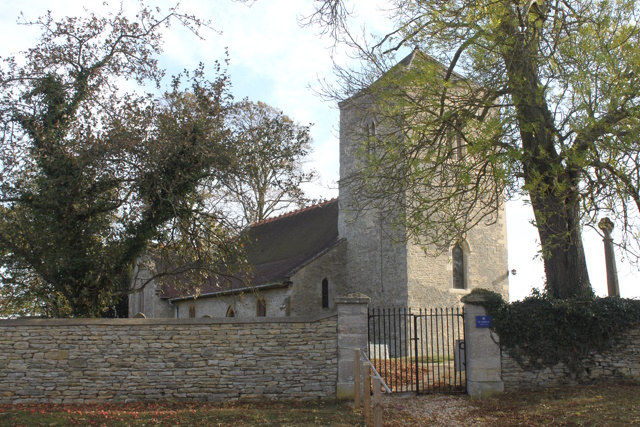


























St Andrew's Church, Oddington
St. Andrew's church in Oddington is a plain stone building, dating mainly from the end of the 13th and beginning of the 14th centuries, but much restored. It comprises a chancel, nave, western tower, south porch, and north aisle. The nave of three bays has late 13th-century buttresses; it has been suggested that there may once have been a chapel on the northern side. The tower with its two stories, steeply-pitched roof of stone slates with no parapet, and lancet windows, together with the south door, are parts of the original church. The chancel retains part of a late 14th-century window and an elegant 14th-century piscina. Dunkin, writing before 1823, described the church as 'disguised by alterations', and Parker, writing before 1846, as 'mutilated' and 'concealed by plaster'. Some of the alterations were of recent date: the south porch, once inscribed 'w.w. 1810', was added in that year; the walls of the nave were lowered, a slate roof put on, and the church paved before 1823 and possibly in 1821, when the chancel was taken down and rebuilt. In 1884–6 a thorough restoration by the architect E. G. Bruton was carried out at a cost of about £1,200. The tower was rebuilt, a north aisle and chapel on the north side of the chancel were added, and some new windows inserted. The plain circular font is probably 13th-century, and the pulpit is Jacobean. The chancel screen with rood-loft, described by Rawlinson as being carved with white and red roses, though still there in 1823, no longer exists. Fragments of medieval glass, which in Rawlinson's time represented St. Peter, are in the east window. The royal arms were formerly over the chancel arch. There is an undated brass in the chancel to Ralph Hamsterley, Rector of Oddington and Fellow of Merton College (d. 1518); he is represented as a skeleton in a shroud, being eaten by worms. There are also some 17th- and 18th-century inscriptions to other Oddington rectors: James Robins, minister (d. 1659), Henry Brocker (d. 1679), Thomas Dickinson (d. 1746) and his wife Jane (d. 1733), and to John Bruere (d. 1776). There are stone slabs to Gabriel Braithwaite (d. 1686/7) and William Dickinson, brother to the lord of the manor (d. 1716). At the west end there is a large carved pietá, supported on a plinth decorated with carved Maori totems. It is a memorial to the Maoris who fell in the First World War. In 1552 it was recorded that the church owned a silver chalice and an ivory pyx with 'smale spanges of silver'; it was also well provided with vestments, and three bells and two handbells. In 1955 the plate included an early 18th-century silver chalice and paten cover, inscribed with coats of arms, which was the gift of William Phipps, a maltster of Oxford, who leased the small Balliol property in Oddington in the late 17th century. The church was very elaborately furnished in the high church manner by the rector, S. H. Scott (1915–49); it was lit by both electric light and candles in candelabra. There were three bells, two dating from the early 17th century, and a sanctus bell. The registers date from 1571. Between 1644 and 1651 no marriages are entered. In the churchyard there is the ancient base and head of a cross, raised on three steps. It was restored in 1949. Historical information about St Andrews Church is provided by 'Parishes: Oddington', in A History of the County of Oxford: Volume 6, ed. Mary D Lobel (London, 1959), pp. 276-285. British History Online http://www.british-history.ac.uk/vch/oxon/vol6/pp276-285 [accessed 20 February 2023]. St Andrews Church is a Grade II* listed building. For more information about the listing see CHURCH OF ST ANDREW, Oddington - 1369717 | Historic England. For more information about St. Andrews Church see Parishes: Oddington | British History Online (british-history.ac.uk). |

